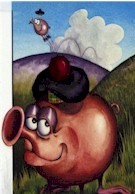Every Scot has fond memories of Robert Burns’ Address To A Haggis.
Here is the story of the Haggis, written by my husband many moons ago; an
original Scottish Recipe, and a reply to the bard’s famous poem, written
in 1990 especially for Clan Fraser, by a former colleague who has tasted
the Haggis.
The Story of the Haggis
by W. Neil Fraser
 January
is the traditional time for gatherings of Scots and Would-be Scots to
celebrate the birthday of Robert Burns [25 Jan 1759-21 July 1796], the
immortal bard of Scotland, and no such event would be complete without the
traditional Address to a Haggis. That said, I think it is time to
come clean with the true story of the origin and contents of "The Haggis".
January
is the traditional time for gatherings of Scots and Would-be Scots to
celebrate the birthday of Robert Burns [25 Jan 1759-21 July 1796], the
immortal bard of Scotland, and no such event would be complete without the
traditional Address to a Haggis. That said, I think it is time to
come clean with the true story of the origin and contents of "The Haggis".
The earliest reference to the Haggis that I could find, described a
Furry Wee Haggis, known to inhabit the wildest reaches of the West
Highlands in the early 13th century. These docile wee creatures
with their plump furry little bodies, short legs and tails and tiny
pointed heads, were able to adapt to the rugged terrain and withstand the
rigors of the harsh climate, existing mainly on a diet of oats. They were
very prolific and provided an alternative source of food for the wild
Highland clans with whom they shared this inhospitable land. Enterprising
craftsmen were able to use the soft furry pelts to fashion purses known as
sporrans, using the tiny paws as tassels and occasionally the heads as
sporran clasps. Haggis calling was once a popular event at many Highland
Games in the area. It has almost died out now, although a version of the
lonely mating call of the wild Haggis "Och New-Och New" may still be heard
at the Strathpeffer Games.
When their numbers grew too plentiful, many Haggis began to migrate
wherever oats grew, always adapting to their new surroundings. Some were
even able to swim the frigid ocean to the Western Islands. The icy cold
waters may have been responsible for one mutation known as the "Skye Blue
Haggis". Another variety with multi-coloured checkered fur can be found on
the Isle of Harris.
Many Haggis found their way into the Grampian mountains and along the
River Spey, where they were greatly prized for their unique flavour,
usually followed quickly by a dram or two of the local water of life. A
few of the more adventurous Haggis managed to climb to the upper reaches
of the Grampians. Their speed was no match for the Golden Eagles, Osprey
and other birds of prey and they did not long survive those predators.
Some hardier specimens reached the rugged coast of Aberdeenshire where
they provided a welcome change to the constant local diet of seafood.
As time and a half went by, a few adventurous wee Haggis found their
way south into the Strathclyde. Legend has it that one day a young
ploughman named Robert Burness, working in a field in the village of
Alloway, near Ayr, turned over a Haggis nest with his plough. The startled
wee creature was promptly taken home to his mother who removed the head,
tail and legs, skinned it and popped it into the pot of boiling water to
supplement the evening meal. Robert, a somewhat sentimental fellow,
decided to dash off a poem to this new-found delicacy.
As more and more Haggis made their way into the Strathclyde, they were
quickly hunted down with clubs and the sport of Haggis-Bashing became
popular. A fresh catch was quickly taken home and devoured with glee,
aided no doubt by Robert’s proud mother, who passed along copies of her
son’s "Address to a Haggis" to all and sundry. Eventually, the supply
could no longer keep up with the demand and the wild Haggis became almost
extinct. Some very enterprising Glasgow butchers began importing the Furry
Wee Highland Haggis, but after a while, even their supply ran out.
Seeing the growing demand for this unique Scottish delicacy, Alistair
Duncan MacBagpipe (later to be famous as Haggis MacBagpipe) came up with
the idea of producing the artificial Haggis so popular today. Alistair
found a ready supply of surplus sheep entrails, usually discarded by his
less inventive competitors. Oats were in plentiful supply in Scotland, as
were the sturdy stomach linings from the processed sheep. With careful
blending of the rights herbs and spices, Alistair was able to produce a
very good substitute for the taste and texture of the wild Furry Wee
Haggis. Alistair’s sales began to boom but, having lacked the foresight to
patent his invention, it was quickly copied all over Scotland.
Emigrating Scots took the recipe for artificial Haggis with them all
over the world. Soon Haggis became a staple dish wherever Scots gathered
in their adoptive country. They continued to celebrate their strange
customs and spread the fame of their beloved ploughman poet, Robbie
Burness (later Anglicized to Burns). The ceremony of the Address to a
Haggis is dedicated to the origin of this delicacy. The Sgian Dubh, a
very sharp short knife, is always used to disembowel the steaming carcass,
just as was done by the ancient Highlanders when a well done Furry Wee
Highland Haggis was removed from the fire. To this day the Sgian Dubh
wielder is always rewarded with a healthy dram of Scotland’s favourite
beverage.
Some hardy varieties of Haggis even ventured south of the border into
northern England. The local residents viewed them as rodents and quickly
exterminated them. This may help to explain why the Sassenach never
developed a taste for this particular Scottish delicacy. To this day they
look upon the Haggis with derision and fail to understand the Scottish
custom, music or diet.
Only in the very remote regions of the West Highlands will one find the
odd surviving specimen of the almost extinct Furry Wee Highland Haggis,
now a protected species. The haunting call of the wild Haggis is a sound
not soon forgotten. It is doubtful that the taste of fresh wild Haggis
will again be enjoyed, and we may forever be subjected to the artificial
variety, but the supply of good Single Malt remains abundant to wash it
down.
An Original Scottish Recipe
 HAGGIS
- One sheep stomach washed and soaked in salted water. The complete pluck
of the sheep. Remove gall from the liver, wash and soak in salted
water. Boil all together, heart, lungs and half the liver. Mix
in 1/4 to 1/2 cup oatmeal. Mix in a little of the liquid in which
the meat was boiled if the mixture seems too dry. Fill the stomach
and tie securely to stop water from entering. Boil gently until skin
is tender. About 2 hours.
HAGGIS
- One sheep stomach washed and soaked in salted water. The complete pluck
of the sheep. Remove gall from the liver, wash and soak in salted
water. Boil all together, heart, lungs and half the liver. Mix
in 1/4 to 1/2 cup oatmeal. Mix in a little of the liquid in which
the meat was boiled if the mixture seems too dry. Fill the stomach
and tie securely to stop water from entering. Boil gently until skin
is tender. About 2 hours.
A Sassenach’s Reply
by James Lear
O Haggis, Scotia’s national meat,
Your praise is sung in verses sweet,
This evening as we take a seat
here at this venue,
We share a very doubtful treat -
you’re on the menu!
On silver platter there you lie,
You’re to be eaten by-and-by,
If ‘twere my choice, I’ll not deny
I’d draw the line,
At serving things to terrify
dear friends of mine.
Sheep’s heart, lungs, liver - what a sight!
Chopped, minced and grated - packed up tight,
Mixed and stirred through half the night
then left to stew,
With oatmeal, onion, making quite
a witch’s brew.
While Scotsmen loud its taste acclaim,
The Haggis really owes its fame,
To Rabbie Burns, to give him name,
the Ploughman Poet,
Who wrote an ‘Address’ to the same
And don’t we know it!
Had Rabbie sampled Chinese dishes,
Roast beef with Yorkshire pud., or fishes,
Kentucky fried, it’s so delicious,
or even curry,
On Haggis he’d have turned malicious
in quite a hurry.
Pity the Scotsman, Haggis-fed,
His eyes deep-sunken in his head,
His life he mostly spends in bed
with some disorder,
While wiser Scots than he are fled
south of the border.
Note well the Sassenach, full of quips,
A laugh forever on his lips,
Strength shows in everything he grips,
his life’s a caper,
All due to eating fish and chips
from some old newspaper.
O thou, who from thy throne divine,
Look’st down on earth with gaze benign,
Deter all Scottish friends of mine
from Haggis eating,
Then much more gladly shall I dine
when with Scots meeting.
The Rights of Woman
by Robert Burns, 1792
While Europe's eye is fixed on mighty things,
The fate of empires and the fall of kings;
While quacks of state must each produce his plan,
And even children lisp the Rights of Man;
Amid this mighty fuss just let me mention,
The Rights of Woman merit some attention.
